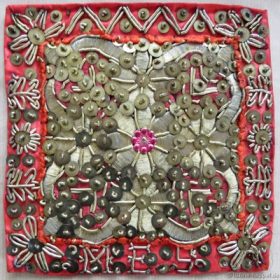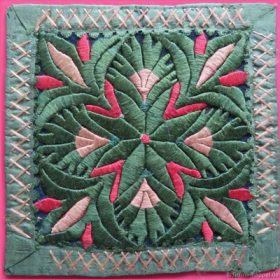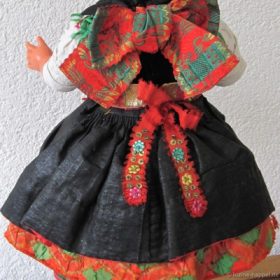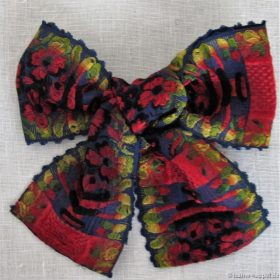There are even more stunning apron squares from the late nineteenth century. During this time, the measurements of the squares grew (up to 19 cm X 19 cm) and the adornment became more and more splendid. They were made in red and green to match the Schwalm costumes.
 The red apron squares had fine silk embroidery consisting mainly of red sections – but included some green areas, too. They were additionally adorned with gold – gold sequins and gold bullion.
The red apron squares had fine silk embroidery consisting mainly of red sections – but included some green areas, too. They were additionally adorned with gold – gold sequins and gold bullion.
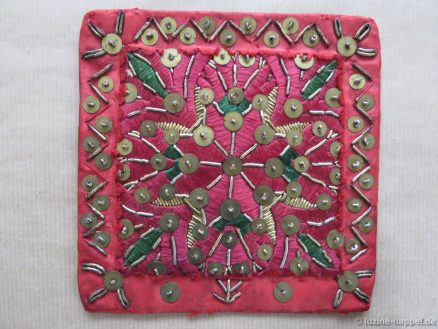 In the beginning, the gold bullion was applied as lines outlining the edges of pattern sections. Later, gold bullion and gold wire were used to fill first small
In the beginning, the gold bullion was applied as lines outlining the edges of pattern sections. Later, gold bullion and gold wire were used to fill first small
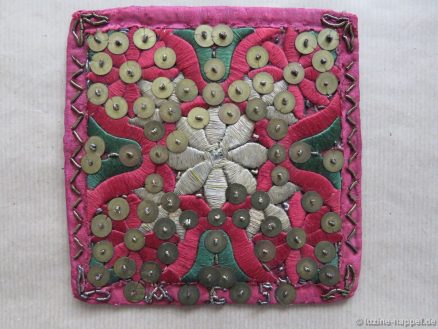 and then larger
and then larger
 and larger pattern sections.
and larger pattern sections.
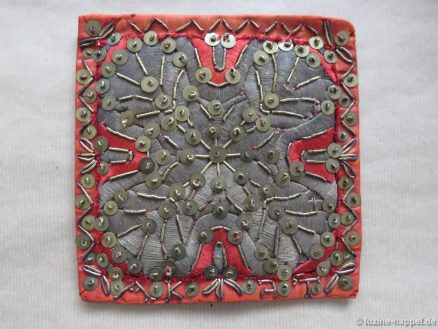 In addition, the edge decoration became more and more elaborate and magnificent.
In addition, the edge decoration became more and more elaborate and magnificent.
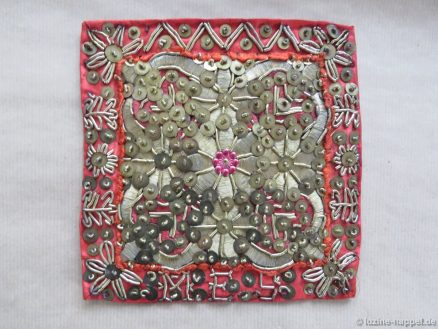 Often the initials of the owner were added at the bottom edge.
Often the initials of the owner were added at the bottom edge.
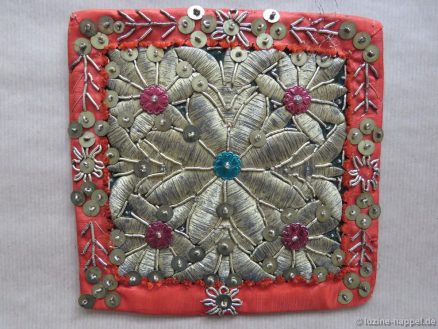 In the end, apron squares were only recognized as red apron squares by the red edging.
In the end, apron squares were only recognized as red apron squares by the red edging.
 Still visible are the Schwalm-typical motifs (star, tulip, and heart) and the important carnation motif.
Still visible are the Schwalm-typical motifs (star, tulip, and heart) and the important carnation motif.
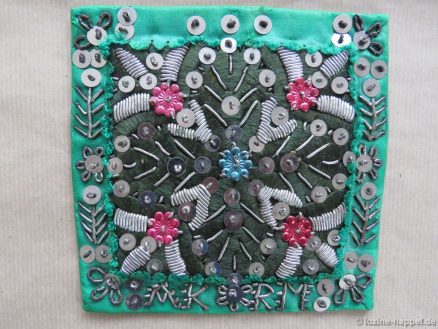 The green apron squares were embellished with silver wire and silver bullion. Additional red embellishments can be found on the costumes for younger women.
The green apron squares were embellished with silver wire and silver bullion. Additional red embellishments can be found on the costumes for younger women.
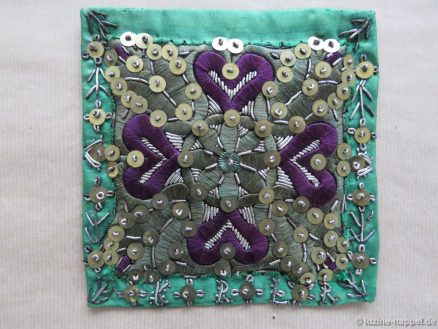 And lilac embellishments are found on the costumes for older women.
And lilac embellishments are found on the costumes for older women.
 The most stunning examples had both silver and gold with green at the edges and a little bit of red on the inside.
The most stunning examples had both silver and gold with green at the edges and a little bit of red on the inside.
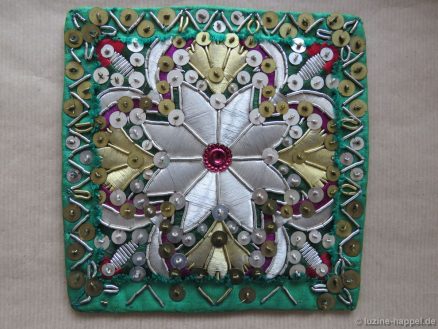 These apron squares are one more accessory that brings magnificence to the Schwalm costume.
These apron squares are one more accessory that brings magnificence to the Schwalm costume.
They are really superb, aren’t they?
Apron squares were originally apron pockets. However, because the fine fabric around the thick pocket area wore too quickly, the utilitarian pocket evolved into the colourful and finely embroidered squares found on Schwalm aprons. The squares, resembling pockets, were pinned onthe dark aprons near the side edges a little below the waistband. And because they were worn to dances, they became known as Tanzecken – dance squares.
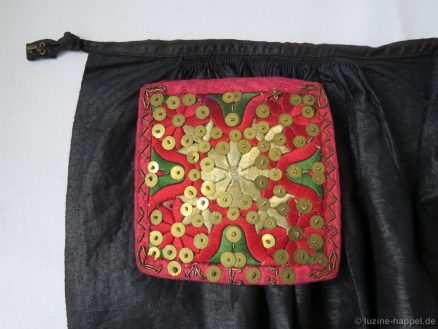 Over time the apron squares got more and more beautiful. Here I show examples from about 1850.
Over time the apron squares got more and more beautiful. Here I show examples from about 1850.
They are significantly less adorned than the apron squares from about 1900. They were embroidered with different colours and in many different patterns. The Schwalm typical motifs (heart, tulip, and star) are found on these accessories. The apron square below measures 16 cm X 16 cm. In general, the early apron squares are smaller with sizes measuring between 11 cm and 14 cm square.
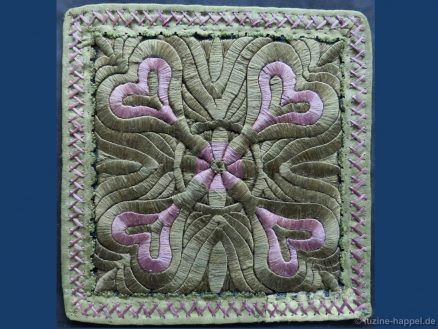 Also the carnation plays a role in the apron square designs.
Also the carnation plays a role in the apron square designs.
Not all apron squares were true squares.
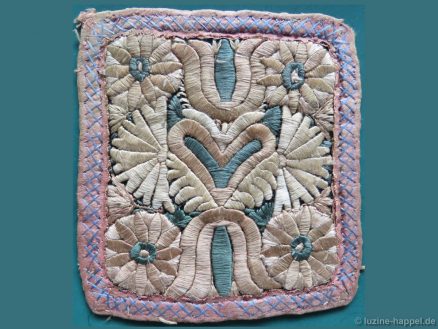 Over time, the colour often faded. One can get an idea of the original brilliant colours by viewing the light-protected back of the above apron square.
Over time, the colour often faded. One can get an idea of the original brilliant colours by viewing the light-protected back of the above apron square.
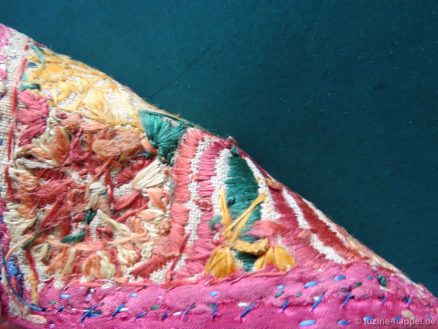 Around the edges silk ribbons were sewn and decorated with Herringbone stitches.
Around the edges silk ribbons were sewn and decorated with Herringbone stitches.
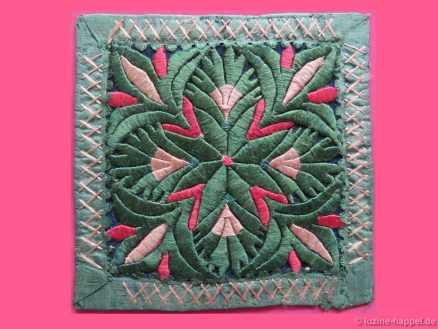 Most patterns were symmetric around the center.
Most patterns were symmetric around the center.
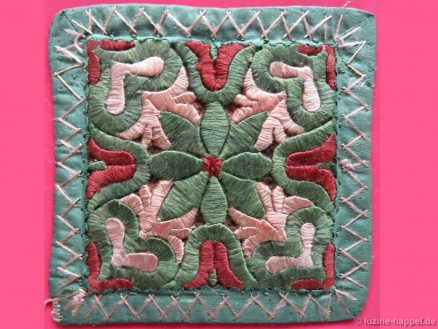 But there are also examples symmetric along the axis.
But there are also examples symmetric along the axis.
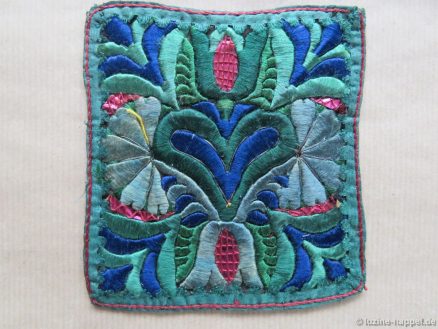 Green and red were the most dominant colours, but blue or lilac is also found.
Green and red were the most dominant colours, but blue or lilac is also found.
The backs of these older apron squares are unlined making it easy to examine the stitches.
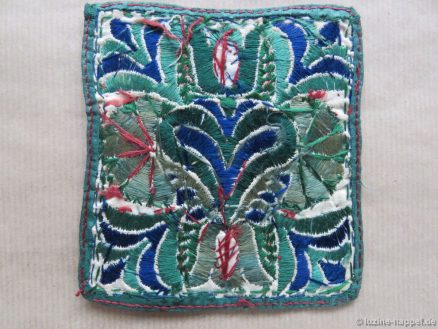 Unfortunately, my collection is limited, and I can only show a few of these early apron squares. But these few give us a glimpse into the aesthetic sense and extreme creativity of our forebears when they created such wonderful patterns and designs.
Unfortunately, my collection is limited, and I can only show a few of these early apron squares. But these few give us a glimpse into the aesthetic sense and extreme creativity of our forebears when they created such wonderful patterns and designs.
Adornments gave the festive Schwalm costume a blaze of colour. And the narrow apron ribbons, in the Schwalm called Schürztuchschnürchen or Forzbengelchen, were no exception. Richly ornate, the colourful narrow ribbons lay on the back of the skirts.
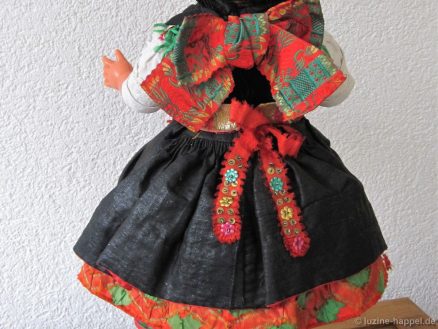 Small silk ribbons were decorated with sequins, bullion, and small flowers or stars made of metal.
Small silk ribbons were decorated with sequins, bullion, and small flowers or stars made of metal.
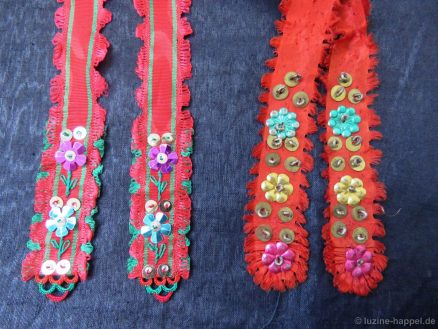 The ribbons were usually unlined, only sometimes a paper strip on the back gave stiffness.
The ribbons were usually unlined, only sometimes a paper strip on the back gave stiffness.
 The silk ribbons were mostly monochromatic, and their edges did not have plain selvages. The weft threads were laid at different sized loops so that an additional effect was established.
The silk ribbons were mostly monochromatic, and their edges did not have plain selvages. The weft threads were laid at different sized loops so that an additional effect was established.
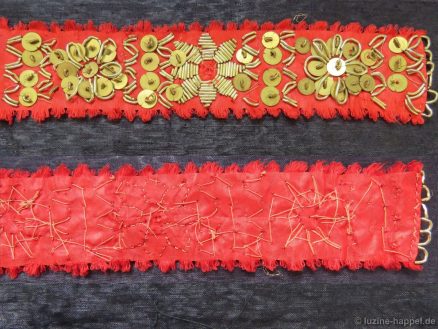 Sometimes a somewhat wider ribbon was added to the ends of a narrower main silk ribbon.
Sometimes a somewhat wider ribbon was added to the ends of a narrower main silk ribbon.
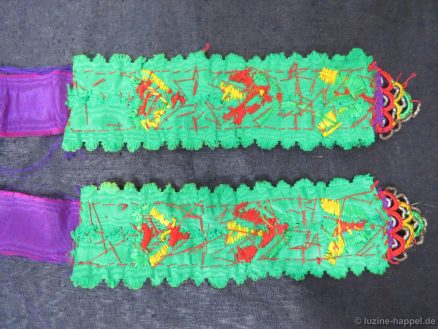 From the front the edges of the wider ribbon were visible thus creating one more effect.
From the front the edges of the wider ribbon were visible thus creating one more effect.
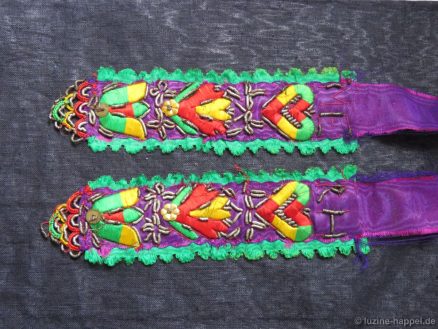 The embellishments on the narrow silk ribbons were very different. Some older ribbons have Tritzer in different colours (these shown here are unfortunately faded a little bit) which were studded with sequins.
The embellishments on the narrow silk ribbons were very different. Some older ribbons have Tritzer in different colours (these shown here are unfortunately faded a little bit) which were studded with sequins.
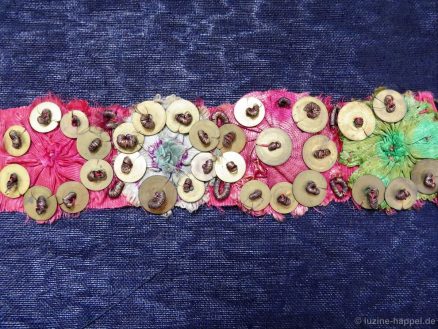 Other ribbons were decorated with sequins and bullion only.
Other ribbons were decorated with sequins and bullion only.
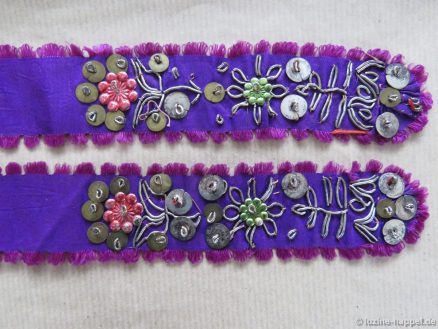 Sometimes templates were fastened onto the ribbons
Sometimes templates were fastened onto the ribbons
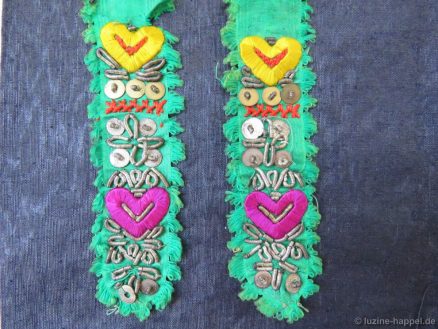 and embroidered with colourful silk threads.
and embroidered with colourful silk threads.
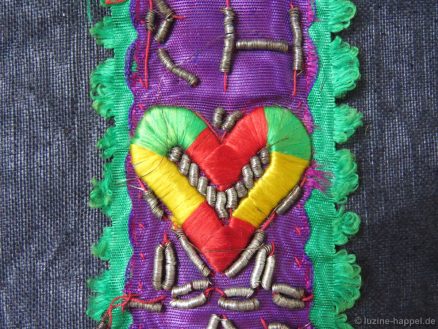 On other ribbons the bullion was expertly applied in the shapes of the common Schwalm motifs:
On other ribbons the bullion was expertly applied in the shapes of the common Schwalm motifs:
heart, tulip, and star.
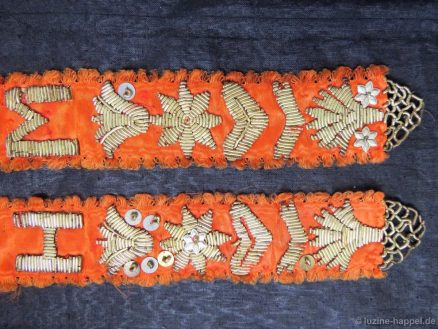 Very elaborate examples also had the initials of the owner.
Very elaborate examples also had the initials of the owner.
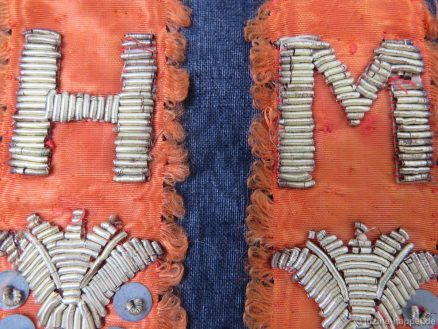 Often the ends of the ribbons were additionally decorated with needlelace
Often the ends of the ribbons were additionally decorated with needlelace
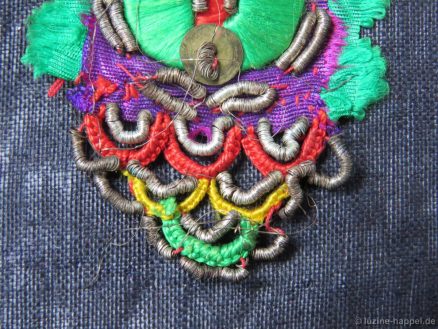 or bullion applied to look like needlelace.
or bullion applied to look like needlelace.
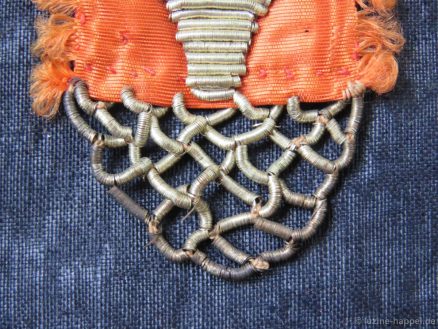 Tied into a small bow or hung onto the apron’s waistband with a simple cow hitch, the colourful and richly decorated narrow ribbons, falling onto the back of the skirts, brightly contrasted against the black or dark blue linen.
Tied into a small bow or hung onto the apron’s waistband with a simple cow hitch, the colourful and richly decorated narrow ribbons, falling onto the back of the skirts, brightly contrasted against the black or dark blue linen.
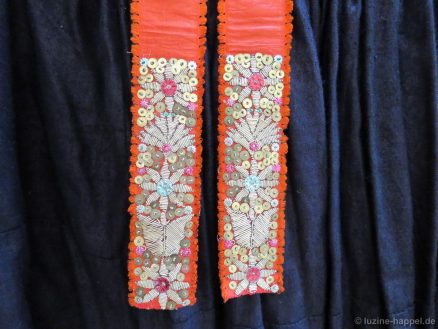
In addition to the coloured woven silk bands, some Schwalm women owned special apron waistbands. Reflecting their owner’s prosperity or dexterity, these special waistbands were accordingly very different from one another.
So, there were narrow monochromatic silk ribbons that were sewn upon the dark aprons waistbands
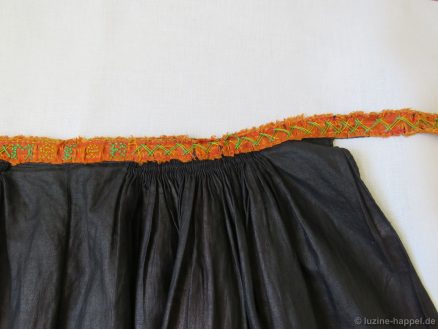 and then decorated with initials and small ornaments in Cross stitch and different coloured stitches.
and then decorated with initials and small ornaments in Cross stitch and different coloured stitches.
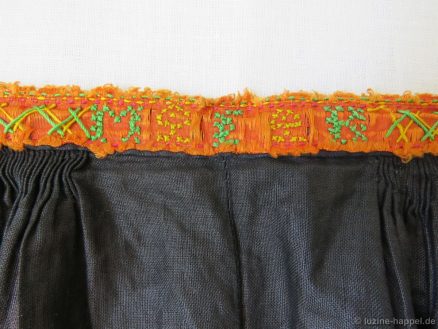 But there were much more elaborate bands worked to simulate a girdle. The unlined back side of such a band shows how it was made. A strong linen strip (ecru) was covered with a wider linen strip (blue), which was folded to the back over the edges. Small green silk ribbons were fastened at the edges.
But there were much more elaborate bands worked to simulate a girdle. The unlined back side of such a band shows how it was made. A strong linen strip (ecru) was covered with a wider linen strip (blue), which was folded to the back over the edges. Small green silk ribbons were fastened at the edges.
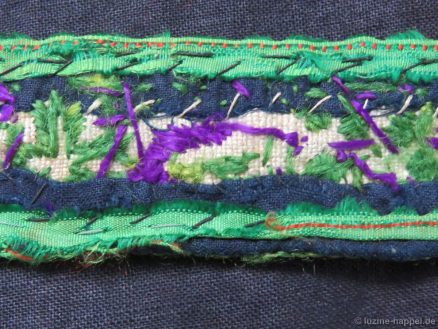 On the front different paper board shapes were fastened. The templates were embroidered with silk threads (lilac) and woolen yarn (green) with densely worked Satin stitches.
On the front different paper board shapes were fastened. The templates were embroidered with silk threads (lilac) and woolen yarn (green) with densely worked Satin stitches.
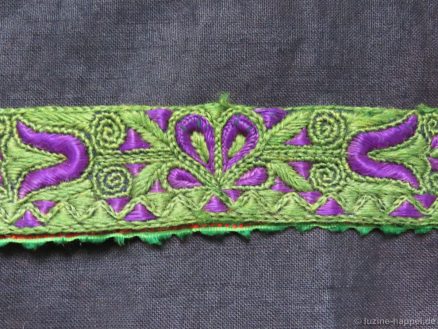 Spaces between the template sections were painstakingly filled with Coral Knot stitches, Blanket stitches, Chain stitches, and Satin stitches.
Spaces between the template sections were painstakingly filled with Coral Knot stitches, Blanket stitches, Chain stitches, and Satin stitches.
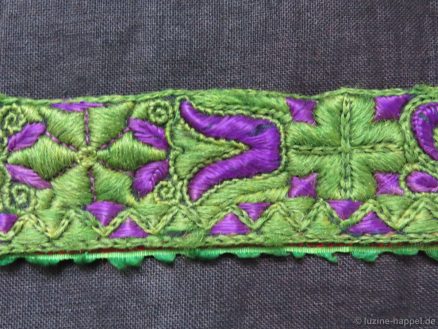 The main motifs in this example are heart, tulip, star, and cross.
The main motifs in this example are heart, tulip, star, and cross.
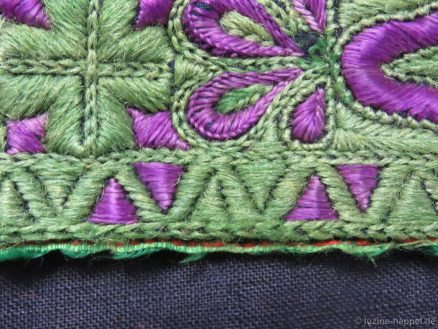 At the edges small borders were embroidered in a zigzag line.
At the edges small borders were embroidered in a zigzag line.
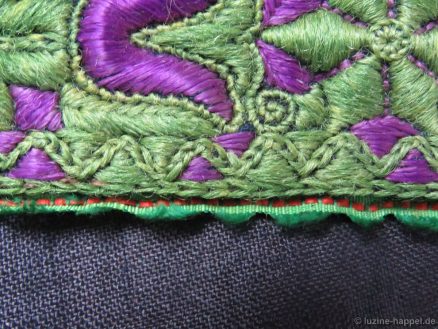 In the back, the waistbands were fastened with a gold-plated clasp – the small chains enabled the waistband to be adjusted to fit different girths.
In the back, the waistbands were fastened with a gold-plated clasp – the small chains enabled the waistband to be adjusted to fit different girths.
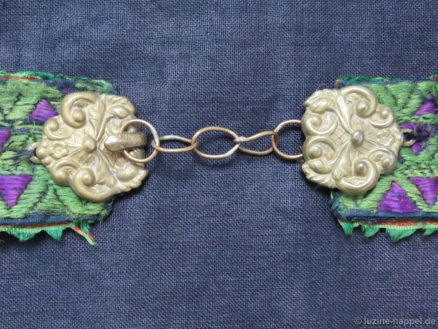 A band embroidered with silk threads only is very colourful. A green silk ribbon was laid onto a wider red silk ribbon. The templates were fastened onto the green ribbon
A band embroidered with silk threads only is very colourful. A green silk ribbon was laid onto a wider red silk ribbon. The templates were fastened onto the green ribbon
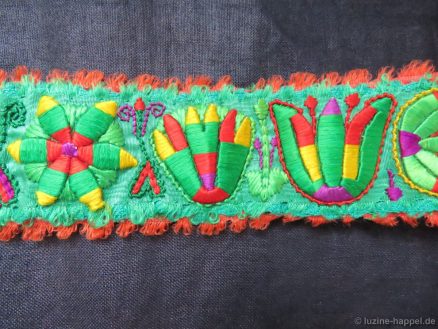 and embroidered with different colours.
and embroidered with different colours.
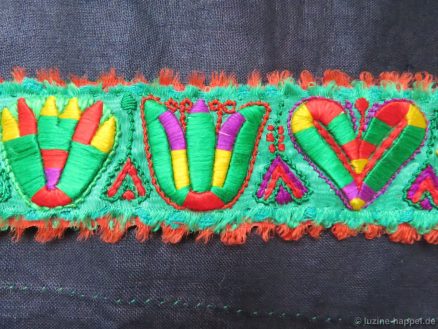 The spaces between the heart, tulip, star, and other motifs were only partially embroidered so that the silk ribbon can be seen.
The spaces between the heart, tulip, star, and other motifs were only partially embroidered so that the silk ribbon can be seen.
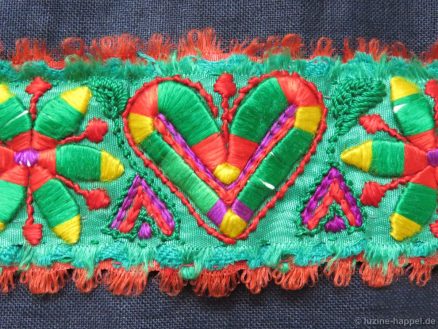 This apron waistband was lined with a colourful cotton fabric.
This apron waistband was lined with a colourful cotton fabric.
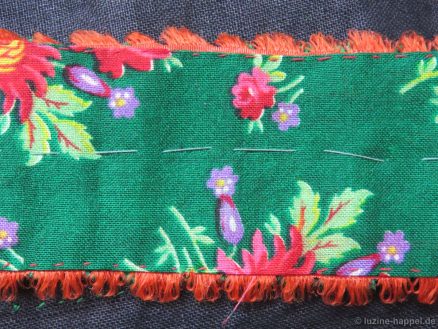 This apron waistband was also closed with a gold-plated clasp.
This apron waistband was also closed with a gold-plated clasp.
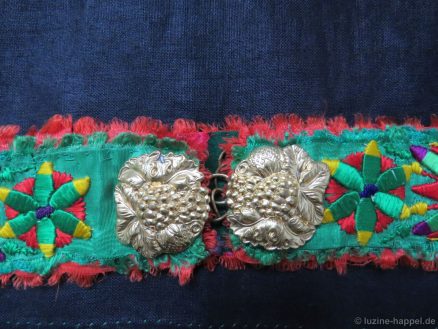 These special apron waistbands were fanciful and established a special splendor, but only wealthy women were able to afford such elaborate bands. The majority had to be content with the coloured woven silk bands.
These special apron waistbands were fanciful and established a special splendor, but only wealthy women were able to afford such elaborate bands. The majority had to be content with the coloured woven silk bands.
Schwalm women kept a large array of colourful bands made of silk or a combination of silk and metal threads; these ribbons were needed for different uses.
The coloured bands decorated the bottom edges of the Schwalm skirts.
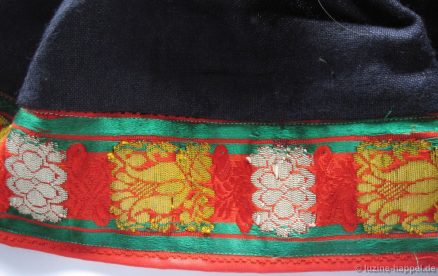 And they were worn like a girdle covering the waistbands of the dark aprons.
And they were worn like a girdle covering the waistbands of the dark aprons.
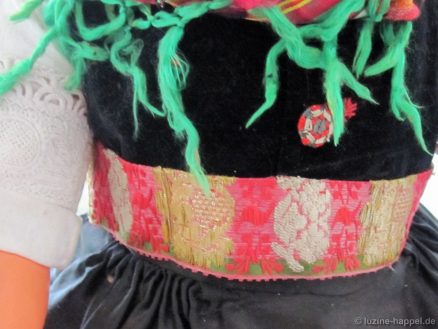 In the back, they were fastened with a hook and eye.
In the back, they were fastened with a hook and eye.
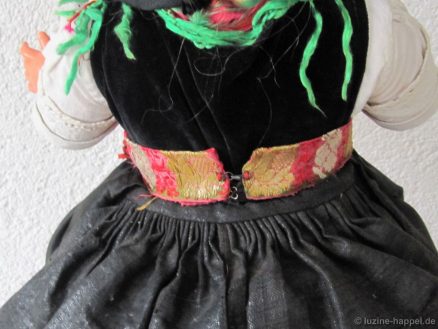 However, sometimes the bands were tied into a bow in the front.
However, sometimes the bands were tied into a bow in the front.
They were also tied into a bow and then pinned at the back of the neck of the waistcoat, but only if the occasion did not dictate that the cap bands with their beautiful embellishments were to be worn in the back.
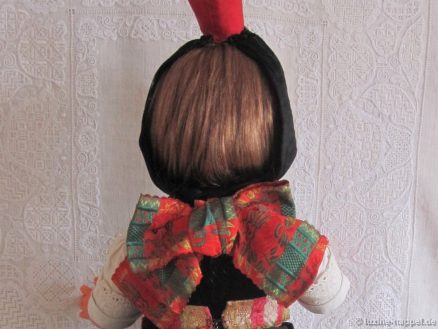 Coloured bands were used to make simple garters, which were sometimes additionally decorated with gold or silver bullion, sequins, and needlelace.
Coloured bands were used to make simple garters, which were sometimes additionally decorated with gold or silver bullion, sequins, and needlelace.
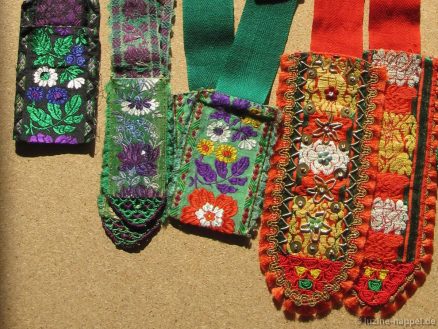 They were used for making the Lust, the decoration found on the groom’s cap
They were used for making the Lust, the decoration found on the groom’s cap
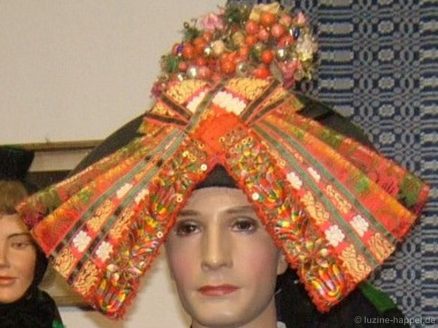 as well as for manufacturing the Geschappel for the bridesmaid and the bride.
as well as for manufacturing the Geschappel for the bridesmaid and the bride.
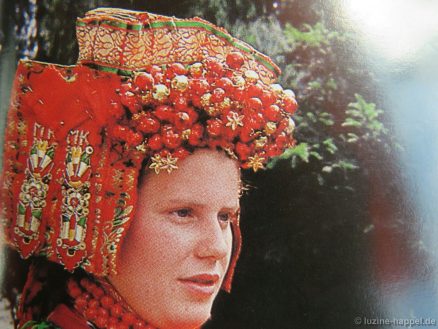 A couple of bands were needed for the Bretter (boards) of the “boardmaids.”
A couple of bands were needed for the Bretter (boards) of the “boardmaids.”
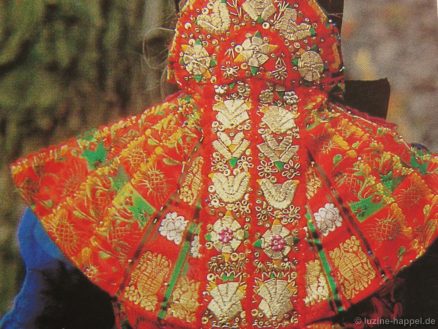 Young girls showed off their most beautiful bands in a special custom – the Pfingstbügel.
Young girls showed off their most beautiful bands in a special custom – the Pfingstbügel.
 Therefore, beautiful coloured silk ribbons were needed in large quantities, so it is not surprising that they were woven in many patterns. Because the young girls wanted to present themselves most attractively (so that they might marry well), the red coloured ribbons were the most popular.
Therefore, beautiful coloured silk ribbons were needed in large quantities, so it is not surprising that they were woven in many patterns. Because the young girls wanted to present themselves most attractively (so that they might marry well), the red coloured ribbons were the most popular.
The bands were woven with silk or silk combined with metal threads. They had widths of approximately 4 cm up to 9 cm. Most common were bands with a width of 6.5 cm. The following are a sampling of different band patterns – included are some very old examples.
Bands with a red ground belonged to the red Schwalm costume. This costume was worn by girls up to the time they married.
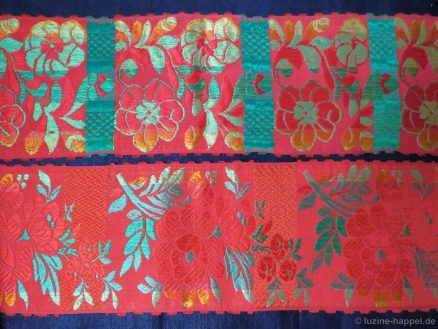
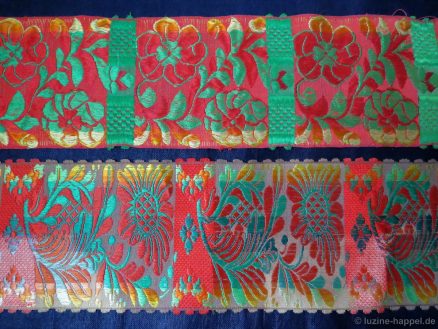
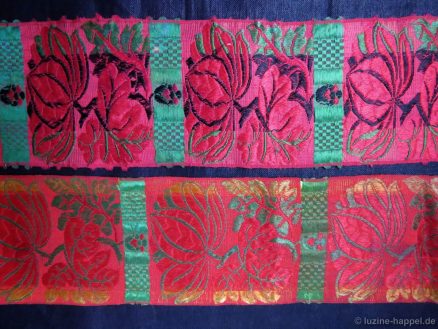
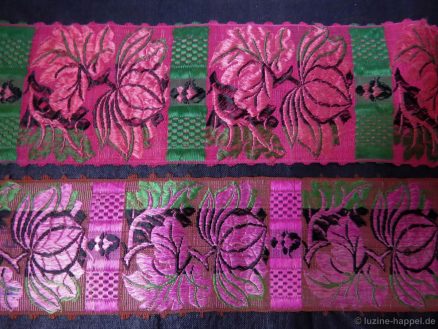
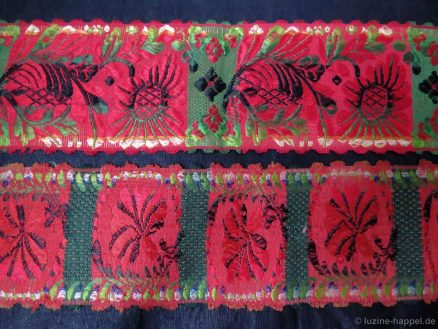
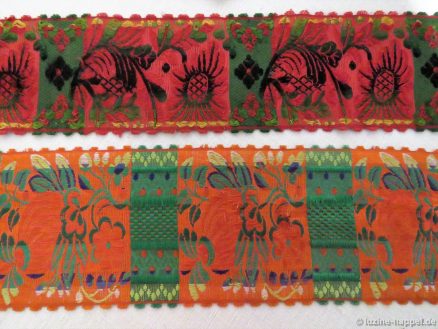
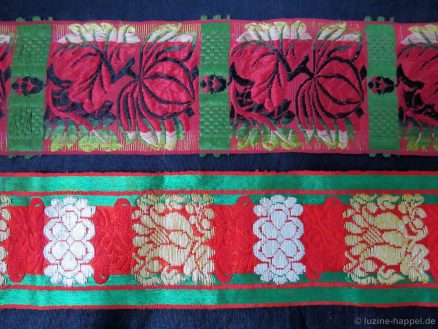
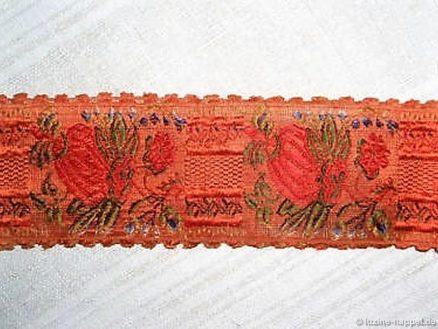 Bands with a green ground and red patterns belonged to the green Schwalm costume. This costume was worn by young women until shortly after their marriage.
Bands with a green ground and red patterns belonged to the green Schwalm costume. This costume was worn by young women until shortly after their marriage.
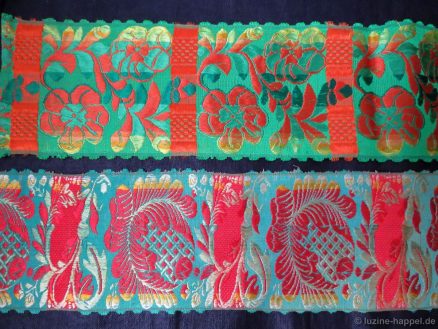
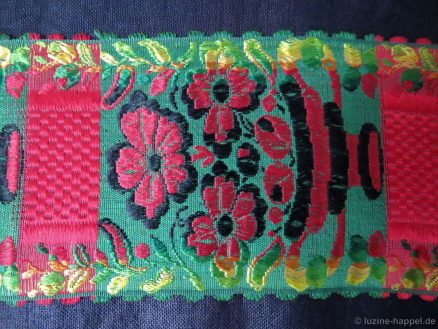
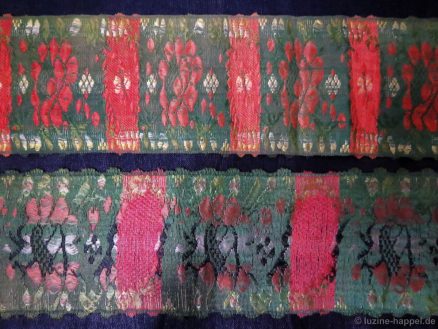
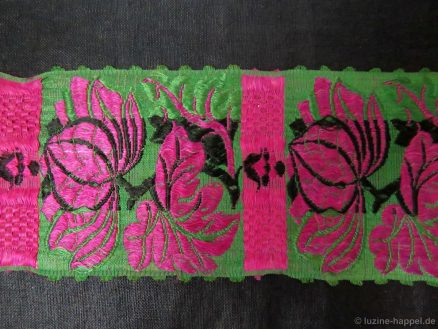 Bands with a green ground and lilac patterns also belonged to the green Schwalm costume. This costume was worn by older women up to 40 years old.
Bands with a green ground and lilac patterns also belonged to the green Schwalm costume. This costume was worn by older women up to 40 years old.
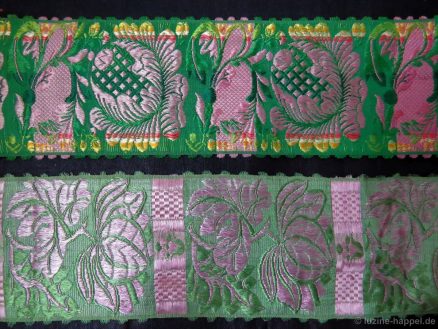 Bands with a blue or lilac ground belonged to the blue Schwalm costume. This costume was worn by women between 40 and 50 years old.
Bands with a blue or lilac ground belonged to the blue Schwalm costume. This costume was worn by women between 40 and 50 years old.
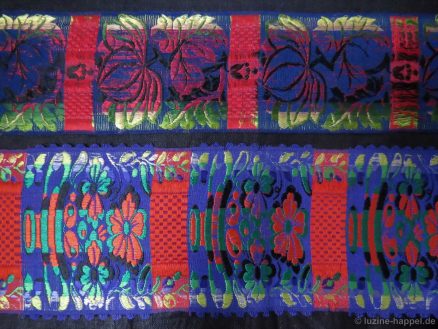
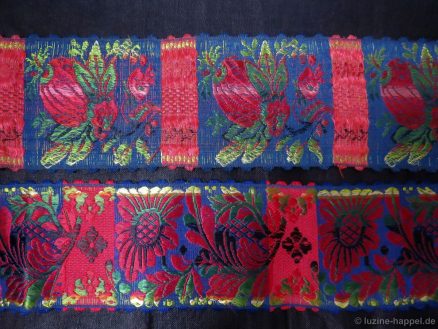
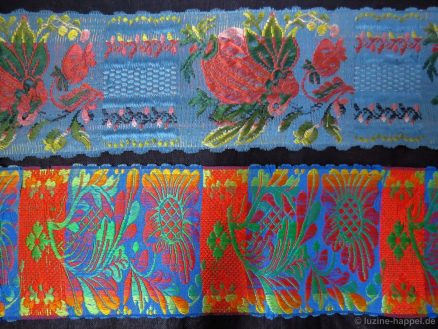
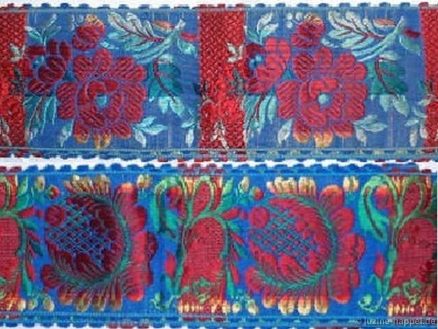
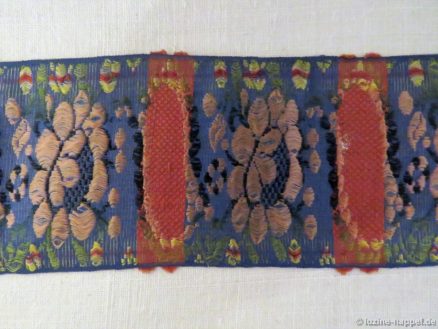
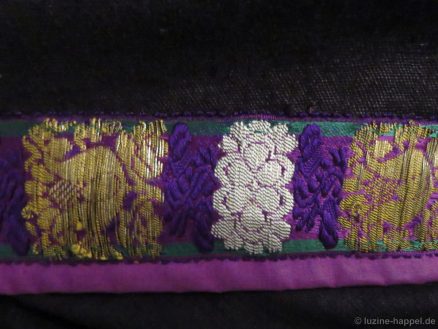 Of course there are single patterns in different colour combinations. Ribbon weaving mills were found in the region around Wuppertal. But most of the bands used in the Schwalm were imported from France.
Of course there are single patterns in different colour combinations. Ribbon weaving mills were found in the region around Wuppertal. But most of the bands used in the Schwalm were imported from France.
Seeing the beauty and the splendor of the ribbons and keeping in mind that Schwalm women had a rather poor life, one can appreciate how much they loved and why they collected these ribbons. It is not surprising that Schwalm women wanted to show them off.
